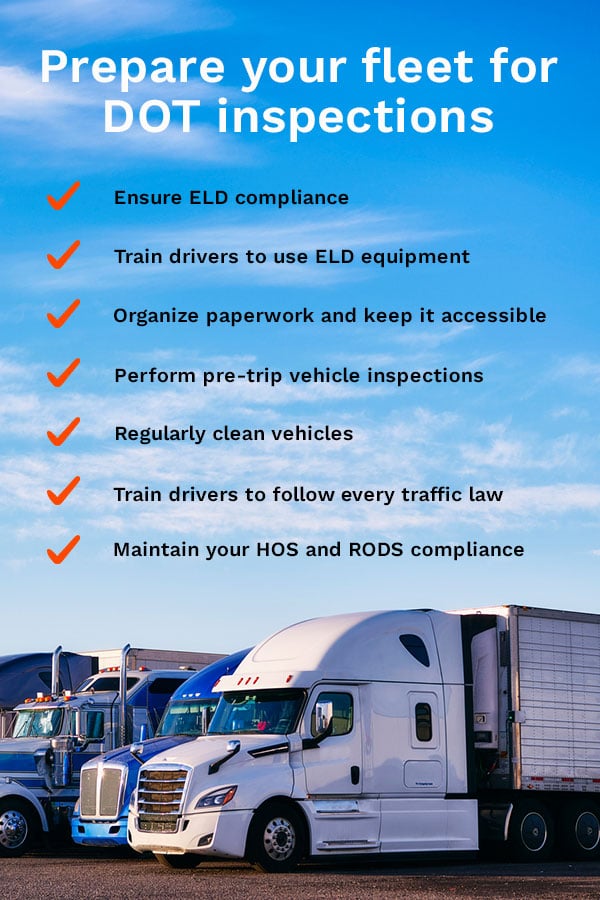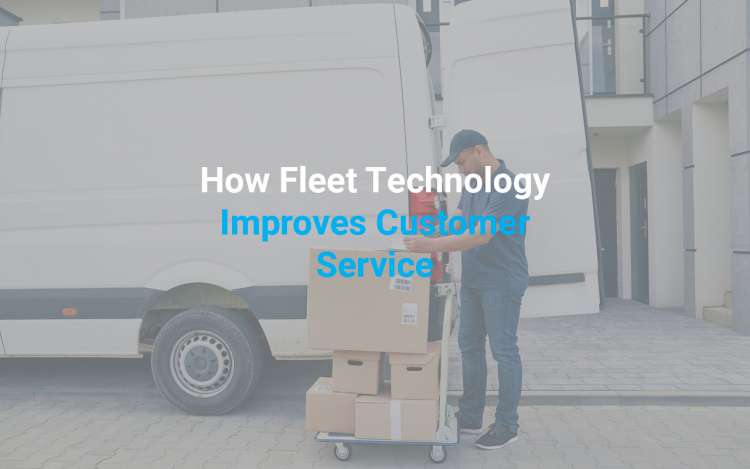The Ultimate Guide to DOT Road Inspections
If you operate a fleet of commercial vehicles, ensuring your drivers pass Department of Transportation roadside inspections is crucial to your company's success. By knowing what to expect in DOT roadside inspections and how to pass them, you can train your drivers and put rules in place to avoid violations. Regularly passing inspections can increase your company's productivity and profitability, as you'll avoid having your drivers or vehicles placed out of service.
Review our guide to DOT inspection levels to learn more about what they are and how you can take steps to reduce violations.
What is a DOT Roadside Inspection?
As the name suggests, a trained, certified inspector such as a state police officer or DOT employee performs DOT inspections. During this process, the inspector will ensure the vehicle's accessories and parts are functioning correctly, in good condition, and safe to use.
These inspections apply to all commercial motor vehicles weighing more than 10,000 pounds. After an inspector approves the vehicle, the driver will receive relevant documentation showing the vehicle passed inspection. The purpose behind these inspections is to ensure U.S. roadways are as safe as possible, so fleet managers must prioritize DOT compliance for all their commercial motor vehicles.
Guide to DOT Inspection Levels
If your company has a fleet of commercial motor vehicles, you might be wondering, "What are DOT inspection levels?" Since there are many essential differences between DOT inspection levels, you can better prepare for various inspections by knowing more about these and what they entail. By being aware of what happens in a roadside inspection based on the level, you can more effectively train your team to comply with regulations.
Find out more about the eight DOT inspection levels to know more about what to expect in DOT roadside inspections below.
Level I: North American Standard Inspection
This level is the most thorough and comprehensive DOT inspection, as it is a 37-step procedure. In this examination, the inspector will review the entire vehicle, checking for damaged or worn-down parts. As they examine the vehicle, they'll check various components, such as the vehicle's brakes, exhaust system, coupling devices, fuel system, tires, steering mechanism, turn signals, and trailer bodies. Alongside these parts, the inspection involves checking many other accessories and components to ensure they're in working order.
Alongside inspecting the vehicle, the inspector will also talk to the driver to see if they're operating their vehicle appropriately. For example, the inspector will look for signs of the driver using drugs or alcohol while driving. Additionally, they'll review the driver's documentation and seat belt usage to ensure everything is in order. Some of the primary driver documents include the driver and vehicle inspection report, driver's hours of service and daily log, the operator's driver's license, and the driver's medical card and waiver.
Level II: Walk-Around Driver/Vehicle Inspection
The Level II inspection is very similar to a Level I inspection, except it doesn't require the inspector to be as thorough. While they will still examine the driver and vehicle, they won't need to do any checks requiring them to get physically underneath the vehicle. After the inspector walks around the vehicle and checks the required parts, they'll ensure the driver has all the appropriate credentials and documents.
Level III: Driver/Credential/Administration Inspection
A Level III inspection only involves checking a driver's paperwork and credentials. Typically, an inspector will ask for a driver's hours of service, license, electronic logging device, driver vehicle inspection report, and record of duty status. The inspector will also ensure the driver is using their seat belt and refraining from drug and alcohol use.
Level IV: Special Inspections
When an inspector conducts a Level IV inspection, they'll be examining a specific part or item of a commercial vehicle. Generally, these inspections are only to study particular trends or components, such as a vehicle's engine and driver documentation. Inspectors may also want to conduct these inspections to find evidence for or against a previous study's findings.
Level V: Vehicle-Only Inspection
In a Level V Inspection, an inspector will follow all the steps from Level I, except they won't evaluate the driver. In most cases, the driver isn't present for these kinds of inspections. Generally, Level V inspections occur at a carrier's location while a commercial vehicle undergoes a compliance review.
Level VI: Enhanced North American Standard Inspection for Radioactive Shipments
When a commercial motor vehicle transports highway route controlled quantities of radioactive materials, they must pass a Level VI inspection, one of the most specialized DOT roadside inspection levels. Since radioactive materials can be dangerous if mishandled, drivers and commercial motor vehicles that transport them must meet high standards. During an inspection, the inspector will conduct an examination based on an enhanced Level I inspection, with additional radiological criteria, extra inspection procedures, and enhanced out-of-service requirements.
Before any driver leaves with radioactive material, drivers, cargo, and the vehicle must be defect-free. Commercial motor vehicles carrying these radioactive materials should have a special nuclear symbol attached to them at the shipment's point of origin. Once the shipment reaches its destination, the nuclear symbol becomes invalid, and the driver must remove it.
Level VII: Jurisdictional Mandated Commercial Vehicle Inspection
A Level VII inspection involves any inspection program manded by a jurisdiction that doesn't meet any other inspection level's requirements. Generally, these inspections apply to hotel courtesy shuttles, shared-ride transportation, intra-provincial or intrastate operations, and school buses. Alongside certified inspectors, qualified government employees and contractors can complete these inspections.
Level VIII: North American Standard Electronic Inspection
When a commercial motor vehicle undergoes a Level VIII inspection, an inspector will examine it electronically or wirelessly. This inspection occurs on the road while the operator drives the vehicle, so the inspector doesn't have to be present.
Since the inspector performs this process electronically, a vehicle must be able to facilitate relevant data exchange. Some of the relevant data points the vehicle must transmit for this inspection to be valid include:
- The USDOT number
- Descriptive location featuring GPS coordinates
- License status
- HOS compliance
- Power unit registration
- Vehicle operator electronic validation
- Operating authority

Common DOT Inspection Violations
Besides knowing more about the eight DOT inspection levels, you can also set your fleet up for success by being aware of the most common violations drivers and companies regularly commit. If drivers or vehicles violate regulations, the violation can put them out of service. When a vehicle is out of service, a company will either need to tow it to another location or have on-site repairs conducted. Out-of-service drivers will need another driver to pick them up to continue driving their vehicle.
When a driver or vehicle is out of service due to violations, the process to get the commercial motor vehicle back on the road can take a long time. By reviewing common violations, you can take steps to reduce them and remain in compliance with various DOT regulations.
Take a moment to review some of the common DOT roadside inspection violations below:
- Expired or invalid driver's license
- Lack of a medical card or an expired one
- Violation of hours-of-service laws
- Drivers not wearing their seat belts
- Logging violations
- Improperly operating a commercial motor vehicle per a jurisdiction's ordinances, regulations, and laws
Some typical violations affecting commercial motor vehicles include:
- Fuel, transmission fluid, oil, or grease leaks
- Incorrectly loaded cargo
- Unsecured or discharged fire extinguishers
- Pushrod stroke exceeding a specified value
- Inoperable mandatory lamps and lights
- Lack of current annual inspection on file
- Tire tread depth under 2/32"
- Parts not in proper or safe operating conditions
Prepare Your Fleet for DOT Inspections
If you want to know how to pass DOT roadside inspections, you can start by following a few best practices. The top fleet managers take the time to train drivers to pass their inspections. Some of the best tips for passing DOT inspections include ensuring ELD compliance, organizing paperwork, and training drivers to follow traffic laws.
Find out more about how to avoid DOT violations below.
1. Ensure ELD Compliance
One of the most crucial steps you can take to prepare your fleet for DOT inspection is to ensure every commercial motor vehicle is ELD-compliant. Since 2017, the Federal Motor Carrier Safety Administration's ELD rule has been in full effect and applies to most commercial motor vehicles. As a result, inspections will involve checking a driver and vehicle's ELD compliance.
If you want to comply with the ELD rule, your fleet's vehicles must have working ELDs powered on at all times. An effective ELD will also use a Bluetooth or USB connection for data transmission rather than solely relying on a cellular connection. An ELD relying purely on a cellular data connection will stop working in areas without service, preventing engine data from syncing with the driver's smartphone. By using an ELD with additional connections, you protect your drivers from failing an inspection.
2. Train Drivers & Relevant Staff to Expertly Use ELD Equipment
Training your drivers to proficiently use ELD equipment can help them pass inspections. When drivers know where their ELD equipment is and how to email their ELD records to an inspector, they can make the inspection process faster and ensure they provide the inspector with the documentation needed for compliance.
3. Organize Paperwork and Keep it Accessible
Another way companies that know how to pass DOT inspections prevent violations is to ensure their drivers keep their paperwork accessible. When an inspector examines a vehicle, they'll likely need to see relevant paperwork like your drivers' HOS compliance records, medical examiner's certificate, and commercial driver's license. If your fleet's drivers keep their paperwork easily accessible and organized, your drivers will be more likely to pass inspections.
4. Perform Pre-Trip Vehicle Inspections
Before any of your drivers take a commercial motor vehicle on a trip, you can reduce their chances of running into compliance issues by inspecting the vehicle first. By inspecting the vehicle, your team is more likely to catch possible infractions and take action on them before the vehicle hits the road. Essential parts to check in this inspection include the headlights, tires, and braking system.
5. Regularly Clean Vehicles
It's also critical for fleet managers to stress the need for drivers to keep their vehicles as clean as possible. By ensuring their vehicles stay clean, a driver helps the inspector do their job faster, as substances like road grime will make it harder for them to spot worn-out parts. Additionally, clean vehicles can improve the inspector's opinion of the driver, potentially helping them pass their inspection.
6. Train Drivers to Follow Every Traffic Law
Another crucial element of fleet compliance is training your drivers to obey all traffic laws. Drivers should be knowledgeable about traffic signals, speed limits, and road signs. They should also be aware of traffic laws specific to the state they're driving in. For example, some states have stricter cellphone laws that make it illegal for a driver to even reach for their phone or hold it up to their ear while making a phone call. Additionally, drivers should always wear a seat belt.
Companies can make it more likely drivers follow traffic laws by training them to drive as safely as possible. Additionally, training can cover specific traffic laws related to the route they're taking.
7. Maintain Your HOS & RODS Compliance
When your vehicles' and drivers' hours of service or records of duty status aren't in compliance, they could end up getting placed out of service. If you want your fleet to be RODS compliant, your drivers will need to log their completed hours every 24 hours.
If you want to meet HOS compliance, drivers must track their driving time and ensure they never exceed their permitted consecutive hours' maximum. Drivers should also take their required days off and rest breaks. With ELDs in your vehicles, you can make it much easier for your drivers to achieve HOS compliance. These devices automatically track and log your engine activity and can even alert drivers who get close to reaching their maximum.

Pass Your DOT inspections with Integrated Fleet Solutions
Now that you've reviewed our DOT roadside inspection guide, you may want to take further action to help your fleet pass their DOT inspections with flying colors. Browse our fleet compliance solutions to ensure your fleet is in compliance with federal regulations. Our scalable and customizable fleet management platform also helps you monitor your fleet and ensure compliance. When you work with us, you can expect best-in-class truck navigation, device portability, solutions for fleets of every size, and 24/7 customer support.
Take a moment to request our pricing to learn more about how our fleet solutions can help your team pass DOT inspections. Alongside providing you with pricing and answering any questions you might have, we can also give you a free demo to ensure our solutions work perfectly for your needs.
Contact Rand McNally
Request Pricing for Fleet Solutions
We're looking forward to talking with you. Please fill out the form to get started.
Or call us:
+1 (800) 789-6277 (Fleet management, ELD, Asset tracking, Navigation)
+1 (800) 234-4069 x2 (MileMaker/IntelliRoute)
If you are an existing customer and need assistance, please contact your Client Success rep or email fleetsupport@randmcnally.com.
This form is for business-to-business transactions only. It is not for personal consumer use.


